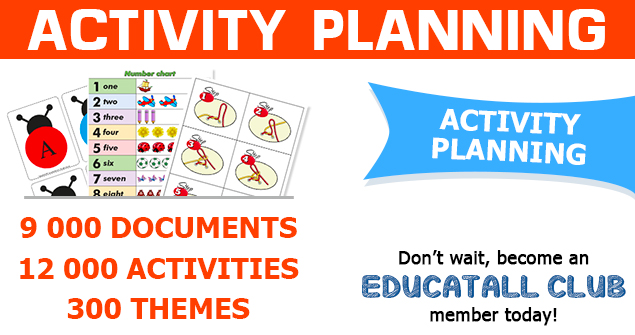Activities for toddlers and babies
This theme will give little ones the chance to explore hot (warm) and cold through a variety of activities. For safety reasons, avoid very hot items. Instead, use warm objects and elements and always check their temperature before presenting them to your group. All activities must be supervised.
AREA SETUP
Display pictures representing hot and cold items on the walls of your daycare. Suggestions: a snowman, soup, a fireplace, an ice pop, etc. Hang snowflake and sun illustrations from the ceiling.
ROUTINES AND TRANSITIONS
Hot (warm) and cold food items
Throughout the week, serve hot (warm) and cold food items. For example, you could serve soup for lunch and then offer children frozen yogurt as an afternoon snack. Identify different hot and cold food items with the children in your group.
The snack
Offer a single food item at snack time, but serve both hot (warm) and cold versions. For example, fill a tiny bowl with cold applesauce and another tiny bowl with warm applesauce. Watch children's reactions as they taste the applesauce in each bowl. Name the hot (warm) and cold sensations for children.
Hand washing
Wash the hands of the children in your group under the faucet. Let cold water run on their little hands followed by lukewarm water. Name the temperature of the water for little ones. Use a new soap dispenser to make this activity extra special.
Go for a walk
When you are out and about with your group on a cold day, help them notice how the sunshine warms their face. Invite them to close their eyes and feel the sun on their cold cheeks.
SENSORY ACTIVITIES (touch)
Hot (warm) and cold manipulation bottles
Fill one plastic bottle with cold water and another plastic bottle with lukewarm water. Add a few drops of food coloring to each bottle to make them more attractive. If you wish, you can add blue food coloring to the bottle filled with cold water and red food coloring to the bottle filled with lukewarm water. Seal the caps with hot glue. Let babies and toddlers manipulate the bottles and feel the difference in temperature on their hands.
Magic bag
Fill a fabric bag with dried beans and set it in the refrigerator until it is very cold (but not freezing). Set a second bag in the microwave for a few seconds, until it is warm. Let babies and toddlers explore the two bags.
ARTS & CRAFTS
Collective project-Ice cream cone
Explore cold by creating a giant ice cream cone as a group. Cut a large triangle out of cardboard to represent the cone. Next, cut circles out of construction paper to represent scoops of ice cream. Have children draw on them, paint them, or decorate them. When they are done, let them glue them on the cone.
MORAL AND SOCIAL ACTIVITIES
Blankets
Use blankets to introduce an imaginary game. Sit on the floor or on a couch with your group. Pretend to be very cold and shiver. Wrap yourselves in the blankets and cuddle close. After a few minutes, pretend to be very hot and remove the blankets one by one. This simple activity will make it possible for little ones to understand how our environment influences our body.
COGNITIVE ACTIVITIES
Water and ice
Fill a small container with lukewarm water and set it on the floor within your daycare. Add large ice cubes (constant supervision required) and let children manipulate them. Encourage them to notice the difference in temperature. They will enjoy watching the ice cubes melt away.
Important: Verify the temperature of the water regularly throughout this activity. Add lukewarm water if the water gets too cold. Use moulds used to play in sand to make large ice shapes. The ice shapes will be larger than regular ice cubes and therefore safer for very young children.
Decorate a tree outside
You will need aluminum pie plates and decorative items such as feathers, transparent paper, and objects found in nature (rocks, branches, pinecones, etc.). Let toddlers explore the material. Show them how to arrange them in the aluminum plates. Add water and a piece of string (let the string hang out of the plates). Leave the plates outside on a cold day. The next day, wiggle the plates to release the ice blocks and hang them in a tree.
PHYSICAL ACTIVITY AND MOTOR SKILLS
Diced fruit
Encourage children to work on their prehension skills by giving them the opportunity to explore food items that are frozen and others that are fresh. Depending on the ages of the children in your group, cut fruit into tiny cubes. Freeze half of the fruit pieces. Arrange frozen and fresh fruit pieces on a platter in front of the children in your group. Let babies and toddlers manipulate them and discover the differences in temperature.
Playing with snow indoors
Outside, children must wear large mittens to play in the snow. To give them the chance to touch snow with their bare hands, fill a large container with snow and bring it indoors. Have children wear aprons and sit them around a table. Scoop small amounts of snow on a tray and let them manipulate it. Watch little hands closely to make sure they don't get too cold.
LANGUAGE ACTIVITIES
Temperature
Print a picture of a sun and a picture of a snowflake. Use adhesive paper to stick them in a window, at children's eye level. When it is snowing outside, go to the window with your group and show them the snowflake picture. Talk about the falling snow. On a sunny day, show them the picture of the sun and talk about how the sun will cause the temperature to rise.
Chantal Millette
Early childhood educator
Educatall.com is not responsible for the content of this article. The information mentioned in this article is the responsibility of the author. Educatall.com shall not be held responsible for any litigation or issues resulting from this article.

 Home
Home Theme activities
Theme activities
 Babies and toddlers
Babies and toddlers
 Arts and crafts
Arts and crafts
 Science
Science
 Creative recipes
Creative recipes
 Tips and tricks
Tips and tricks
 Special needs
Special needs
 Extra activities
Extra activities
 Educ-TV
Educ-TV
 Newsletter
Newsletter  Online store
Online store Educatall club
Educatall club

